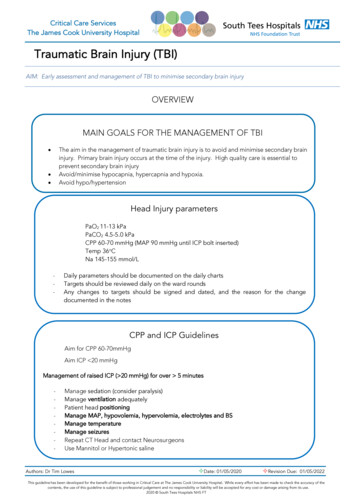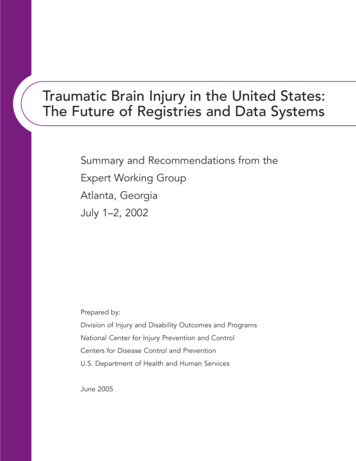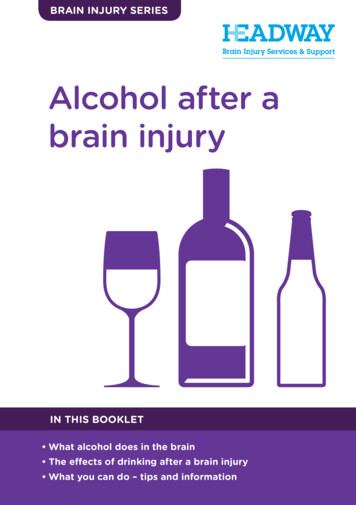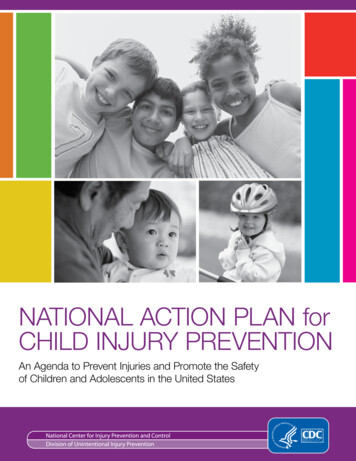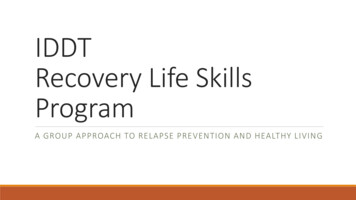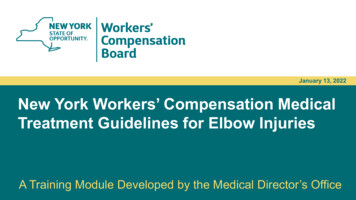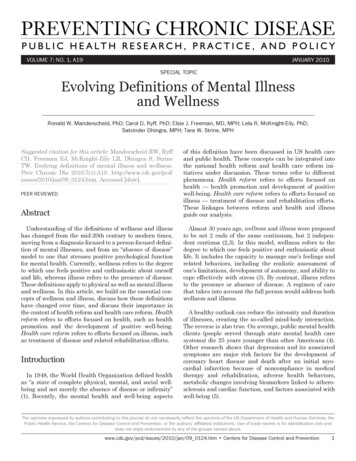
Transcription
DocuSign Envelope ID: 0FE285CE-5DE8-402C-8707-60A7205859B1INJURY AND ILLNESSPREVENTION PROGRAMUNIVERSITY OF CALIFORNIA, DAVISENGINEERING: ELECTRIAL &COMPUTER
DocuSign Envelope ID: 0FE285CE-5DE8-402C-8707-60A7205859B1UC DavisENGINEERING: ELECTRIAL & COMPUTERINJURY AND ILLNESS PREVENTION PROGRAMThis Injury and Illness Prevention Program has been prepared by theUniversity of California, Davis,Department: ENGINEERING: ELECTRIAL & COMPUTERThis written program is in accordance with UC Davis Policy (Policy and Procedures Manual Section290-15: Safety Management Program) and California Code of Regulations Title 8, Section 3203(8CCR§3203: Injury and Illness Prevention Program).2
DocuSign Envelope ID: 0FE285CE-5DE8-402C-8707-60A7205859B1TABLE OF CONTENTSPreface.4Buildings Occupied by Department .4I.Authorities and Responsible Parties .5II.System of Communication .6III.System for Assuring Employee Compliance with Safe Work Practices .7IV.Hazard Identification, Evaluation and Inspection .8V.Accident Investigation .10VI.Hazard Correction.11VII.Health and Safety Training .12VIII.Recordkeeping and Documentation.13IX.Resources .14X.Completed Tasks .153
DocuSign Envelope ID: ENT NAME: ENGINEERING: ELECTRIAL & COMPUTERDEPARTMENT DIRECTOR: Andre KnoesenDEPARTMENT ADDRESS: One Shields Ave Davis, CA 95616DEPARTMENT TELEPHONE NUMBER: 530-754-6123BUILDINGS OCCUPIED BY DEPARTMENT1.Building: Kemper HallUnit(s):administration, research, teaching, faculty and staff officesContact: Carole BustamantePhone: 530-752-24552.Building: Ghausi HallUnit(s):faculty offices, researchContact: Carole BustamantePhone:3.530-752-2455Building: TB207Unit(s):staff, grad student officesContact: Carole BustamantePhone:4.530-752-2455Building: Academic SurgeUnit(s):research, staff officesContact: Carole BustamantePhone: 530-752-24554
DocuSign Envelope ID: 0FE285CE-5DE8-402C-8707-60A7205859B1I.AUTHORITIES AND RESPONSIBLE PARTIESThe authority and responsibility for the implementation and maintenance of the Injury and IllnessPrevention Program (IIPP) is in accordance with University Policy (UCD Policy & Procedure ManualSection 290-15: Safety Management Program) and California Code of Regulations (8CCR, Section 3203)and is held by the following individuals:1. Responsible AuthorityName:Andre KnoesenTitle:Department ChairAuthority:Authority and responsibility for ensuring implementation of this IIPPSignature:Date:3/15/20222. Department Designated AuthorityName:Lance HalstedTitle:Department Safety CoordinatorAuthority:Given by Responsible Authority for implementation of this IIPPSignature:Date:3/15/2022All Principal Investigators/supervisors/managers are responsible for the implementation andenforcement of this IIPP in their areas of responsibility in accordance with University Policy (UCD Policy& Procedure Manual Section 290-15: Safety Management Program).5
DocuSign Envelope ID: 0FE285CE-5DE8-402C-8707-60A7205859B1II.SYSTEM OF COMMUNICATION1.Effective communications with employees have been established using the following methods.Check all boxes that apply, list additional department methods in space provided.XXXXXXXXXStandard Operating Procedures ManualSafety Data SheetsMonthly departmental operations meetingsInternal media (department intranet)EH&S Safety NetsTraining videosSafety NewsletterHandoutsBuilding Evacuation PlanE-mailPosters and warning labelsJob Safety AnalysisDepartmental WebsiteOther (list):2. Employees are encouraged to report any potential health and safety hazard that may exist in theworkplace. Hazard Alert/Correction Forms (Appendix A) are available to employees for this purpose.Forms are to be placed in the Safety Coordinator’s departmental mail box or emailed to them.Employees have the option to remain anonymous when making a report.6
DocuSign Envelope ID: 0FE285CE-5DE8-402C-8707-60A7205859B1III.SYSTEM FOR ASSURING EMPLOYEE COMPLIANCE WITH SAFEWORK PRACTICESEmployees have been advised of adherence to safe work practices and the proper use of requiredpersonal protective equipment (PPE). Conformance will be reinforced by discipline for non-compliancein accordance with University policy (UC Davis Personnel Policies for Staff Members- Section 62,Corrective Action).The following methods are used to reinforce conformance with this program:1.Distribution of Policies2. Training Programs3.Safety Performance EvaluationsPerformance evaluations at all levels must include an assessment of the individual's commitmentto and performance of the accident prevention requirements of his/her position. The followingare examples of factors considered when evaluating an employee's safety performance.4. Adherence to defined safety practices. Use of provided safety equipment. Reporting unsafe acts, conditions, and equipment. Offering suggestions for solutions to safety problems. Planning work to include checking safety of equipment and procedures before starting. Early reporting of illness or injury that may arise as a result of the job. Providing support to safety programs.Statement of non-compliance will be placed in performance evaluations if employee neglects tofollow proper safety procedures, and documented records are on file that clearly indicatetraining was provided for the specific topic, and that the employee understood the training andpotential hazards.5. Corrective action for non-compliance will take place when documentation exists that propertraining was provided, the employee understood the training, and the employee knowinglyneglected to follow proper safety procedures. Corrective action includes, but is not limited to,the following: letter of warning, suspension, or dismissal.Does your department use any additional methods for assuring employeecompliance with safe work practices?YESNO X7
DocuSign Envelope ID: 0FE285CE-5DE8-402C-8707-60A7205859B1IV.HAZARD IDENTIFICATION, EVALUATION AND INSPECTIONJob Hazard Analyses and worksite inspections have been established to identify and evaluateoccupational safety and health hazards.1.Job Safety Analysis:Job Safety Analysis (JSA) identifies and evaluates employee work functions, potential health or injuryhazards, and specifies appropriate safe practices, PPE, and tools/equipment. JSA’s can be completedfor worksites, an individual employee’s job description, or a class of employees’ job description.Completed JSA’s are located in Appendix B.The following resources are available for assistance in completing JSA’s: Laboratory personnel, please refer to the Laboratory Hazard Assessment Tool Non-Laboratory personnel, please refer to the JSA/PPE Certification Forms(Example JSAs are located in Appendix B1 and Appendix B2 of this template)2. Worksite InspectionsWorksite inspections are conducted to identify and evaluate potential hazards. Types of worksiteinspections include both periodic scheduled worksite inspections as well as those required for accidentinvestigations, injury and illness cases, and unusual occurrences. Inspections are conducted at thefollowing worksites:1)Location:Frequency:Kemper Hall Research LabsAnnualResponsible Person: Lance Halsted2)Records Location:on-line (SIT)Location:Ghausi Hall Research LabsFrequency:AnnualResponsible Person: Lance Halsted3)Records Location:on-line (SIT)Location:Academic Surge Research LabsFrequency:AnnualLanceHalstedResponsible Person:Records Location:on-line (SIT)8
DocuSign Envelope ID: 0FE285CE-5DE8-402C-8707-60A7205859B1Worksite Inspections Continued4)Location:TB207 officesFrequency:AnnualResponsible Person: Lance HalstedRecords Location:on-line (SIT)Worksite Inspection Forms C1 - General Office (Available in Appendix C) C2 – Laboratory9
DocuSign Envelope ID: 0FE285CE-5DE8-402C-8707-60A7205859B1V.ACCIDENT INVESTIGATIONUniversity Policy requires that work-related injuries and illnesses be reported to Workers’ Compensationwithin 24 hours of occurrence and state regulation requires all accidents be investigated.Employees will immediately notify their supervisor when occupationally-related injuries and illnessesoccur, or when employees first become aware of such problems.1. Supervisors will investigate all accidents, injuries, occupational illnesses, and near-miss incidents toidentify the causal factors or attendant hazards. Appropriate repairs or procedural changes will beimplemented promptly to mitigate the hazards implicated in these events. Injury reporting procedurescan be found at the Safety Services Website: Injury Reporting.2. The Injury and Illness Investigation Form (see Appendix D) shall be completed to record pertinentinformation and a copy retained to serve as documentation. It can be completed by either thesupervisor or the Department Safety Coordinator.3. Departments must notify EH&S immediately if there is any possibility an employee has been seriouslyinjured. Please refer to EH&S SafetyNet 121 for further information. Immediately: As soon as practically possible, but no longer than eight hours after theemployer knows, or with diligent inquiry, would have known of the death of seriousinjury or illness Serious injury or illness: Any injury or illness occurring in a place of employment, or inconnection with employment, which required inpatient hospitalization for other thanmedical observation or diagnostic testing, or in which an employee suffers andamputation, the loss of an eye, or any serious degree of permanent disfigurement, butdoes not include any injury, illness, or death caused by an accident on a public streetor highway, unless the accident occurred in a construction zone.10
DocuSign Envelope ID: 0FE285CE-5DE8-402C-8707-60A7205859B1VI.HAZARD CORRECTIONHazards discovered either as a result of a scheduled periodic inspection or during normal operationsmust be corrected by the supervisor in control of the work area, or by cooperation between thedepartment in control of the work area and the supervisor of the employees working in that area.Supervisors of affected employees are expected to correct unsafe conditions as quickly as possible afterdiscovery of a hazard, based on the severity of the hazard.Specific procedures that can be used to correct hazards include, but are not limited to, the following: Tagging unsafe equipment “Do Not Use Until Repaired,” and providing a list of alternatives foremployees to use until the equipment is repaired. Stopping unsafe work practices and providing retraining on proper procedures before workresumes. Reinforcing and explaining the need for proper PPE and ensuring its availability. Barricading areas that have chemical spills or other hazards and reporting the hazardousconditions to appropriate parties.Supervisors should use the Hazard Alert/Correction Report (Appendix A) to document correctiveactions, including projected and actual completion dates.If an imminent hazard exists, work in the area must cease, and the appropriate supervisor must becontacted immediately. If the hazard cannot be immediately corrected without endangering employeesor property, all personnel need to leave the area except those qualified and necessary to correct thecondition. These qualified individuals will be equipped with necessary safeguards before addressing thesituation.Does your department have any additional Hazard Correction Procedures?YESNO X11
DocuSign Envelope ID: 0FE285CE-5DE8-402C-8707-60A7205859B1VII.HEALTH AND SAFETY TRAININGHealth and safety training, covering both general work practices and job-specific hazard training is theresponsibility of:Andre Knoesenand immediate Supervisor(s) as applicable to the following criteria:1.Supervisors are provided with training to become familiar with the safety and health hazards towhich employees under their immediate direction and control may be exposed.2.All new employees receive training prior to engaging in responsibilities that pose potentialhazard(s).3.All employees given new job assignments receive training on the hazards of their newresponsibilities prior to actually assuming those responsibilities.4.Training is provided whenever new substances, processes, procedures or equipment (whichrepresent a new hazard) are introduced to the workplace.5.Whenever the employer is made aware of a new or previously unrecognized hazard, training isprovided.The Safety Training Attendance Record form is located in Appendix E.12
DocuSign Envelope ID: 0FE285CE-5DE8-402C-8707-60A7205859B1VIII. RECORDKEEPING AND DOCUMENTATIONDocuments related to the IIPP are maintained in/at/on:2064 KemperThe following documents will be maintained within the department’s IIPP Binder or accessible online folderfor at least the length of time indicated below:1.Hazard Alert/Correction Forms (Appendix A form). Retain for three years.2.Employee Job Safety Analysis form (Example JSA’s in Appendix B).3.Worksite Inspection Forms (Appendix C form). Retain for three years.4.Injury and Illness Investigation Forms (see Appendix D). Retain for three years.5.Employee Safety Training Attendance Records (Appendix E form). Retain for three years.13
DocuSign Envelope ID: UC Office of the President: Management of Health, Safety and the Environment, 10/28/052. UC Davis Policy and Procedure Manual, Section 290-15, Safety Management Program3.California Code of Regulations Title 8, Section 3203, (8CCR §3203), Injury and Illness PreventionProgram4.Personnel Policies for Staff Members, Corrective Action, UC PPSM 625. UC Davis Environmental Health & SafetySafety Services WebsiteEH&S SafetyNetsSafety Data SheetsCampus COVID-19 Prevention Plan6. Does your department have any additional resources?YES XNOhttps://ece.ucdavis.edu/safety14
DocuSign Envelope ID: 0FE285CE-5DE8-402C-8707-60A7205859B1X.COMPLETED TASKSAll tasks are required to be addressed in order to submit this EIIPP for approval:JSA Reviewed:YESXNOAnnual Worksite Inspection completed:YESXNOIIPP Reviewed:YESXNOAnnual IIPP Training completed:YESXNOApproveWell done Lance!15
DocuSign Envelope ID: 0FE285CE-5DE8-402C-8707-60A7205859B1Appendix AHAZARD ALERT / CORRECTION FORMAlert Identification No.Department:I. Unsafe Condition or HazardName: (optional)Job:Title: (optional)Location of Hazard:Building:Floor:Room:Date and time the condition or hazard was observed:Description of unsafe condition or hazard:What changes would you recommend to correct the condition or hazard?Employee Signature: (optional)Date:II. Management/Safety Committee InvestigationName of person investigating unsafe condition or hazard:Results of investigation (What was found? Was condition unsafe or a hazard?): (Attach additionalsheets if necessary.)Proposed action to be taken to correct hazard or unsafe condition: (Complete and attach a HazardCorrection Report)Signature of Investigating Party:Date:IIPP-Appendix A Completed copies of this form should be routed to the appropriate supervisor and departmentJanuary 2022Safety Coordinator, and must be maintained in department files for at least three years.
DocuSign Envelope ID: 0FE285CE-5DE8-402C-8707-60A7205859B1Appendix AHAZARD ALERT / CORRECTION REPORTAlert Identification No.Department:This form should be used in conjunction with the “Hazard Alert Form” as appropriate, to track thecorrection of identified hazards.All hazards should be corrected as soon as possible, based on the severity of the hazard. If a seriousimminent hazard cannot be immediately corrected, evacuate personnel from the area and restrict accessuntil the hazard can be addressed.Supervisor/Safety Coordinator Name:Telephone:Supervisor/Safety Coordinator Signature:Date:Description andLocation of UnsafeConditionIIPP–Appendix AJanuary 2022DateDiscoveredRequired Action andResponsible PartyCompletion DateProjectedActualCompleted copies of this form should be routed to the department Safety Coordinator and kept indepartment files for at least three years.
DocuSign Envelope ID: 0FE285CE-5DE8-402C-8707-60A7205859B1Job Safety Analysis (Part I)Instructions:I amreviewing(check theappropriatebox)1. Select assessment category.2. List tasks/activities: Develop a list of activities, tasks, equipment/tools (group similar tasks/activities).3. Identify and list potential hazards: for each task, activity or equipment/tools, list and describe the potential hazards.4. Identify and list controls: for each task, activity, equipment/tools, document controls (i.e. training, equipment, written procedures, PPE ).5. If PPE is required, complete Part II- PPE Hazard Assessment and Certification.6. Train affected employees on the final assessment and document the training.Repeat assessment when new hazards are identified or introduced into the workplace or at least every three (3) years.Laboratory workers must use the online Laboratory Hazard Assessment Tool (LHAT) for PPE hazard assessment. A worksite A single employee’sjob description A job description for aclass of employeesHazard EvaluatorTASK/ACTIVITYSpecify location:Name of employee:Position title:Position titles: Administrative personnelLocation: Business OfficeSignature/Date:POTENTIAL HAZARDGeneral office workBack strain, eyestrain, repetitivemotion injury. Physical injuriesdue to slips, trips and falls, andfalling objects. Electrical hazards.Physical injuries due to fires,earthquakes, bomb threats andworkplace violence.Operation of motor vehiclesMotor vehicle accidents involvingpersonal injury, or propertydamage.JHA, Version 1.0, November 2014CONTROLEnsure that workstations areergonomically correct. Keep floorsclear of debris and liquid spills.Keep furniture, boxes, etc. fromblocking doorways, halls andwalking space. Do not stand onchairs of any kind, use proper footstools or ladders. Do not storeheavy objects overhead. Do nottop load filing cabinets, fill bottomto top. Do not open more thanone file drawer at a time. Bracetall bookcases and file cabinets towalls. Do not use extension cordsin lieu of permanent wiring.Ensure that high wattageappliances do not overload circuits.Use GFCIs in receptacles inpotentially wet areas. Replacefrayed or damaged electrical cords.Ensure that electrical cords are notdamaged by being wedged againstfurniture or pinched in doors. Allpersonnel to receive annualtraining to the Emergency ActionPlan (EAP) and Injury and IllnessPrevention Plan (IIPP).All drivers of University vehiclesmust possess a valid Californiadrivers license and receive theDriver Safety Awareness Courseoffered by Fleet Services duringthe first 6 months of employmentand renewed every three years.Hazardous materials may not betransported in personally ownedvehicles.PPE Required?Y/NNoNoPage 1 of 2
DocuSign Envelope ID: 0FE285CE-5DE8-402C-8707-60A7205859B1Job Safety Analysis (Part I)Training RecordDesignated Trainer: (signature is required)I have read and acknowledge the contents, requirements, and responsibilities outlined in this document:NameJHA, Version 1.0, November 2014SignatureDatePage 2 of 2
DocuSign Envelope ID: 0FE285CE-5DE8-402C-8707-60A7205859B1Job Safety Analysis (Part I)Instructions:I amreviewing(check theappropriatebox)1. Select assessment category.2. List tasks/activities: Develop a list of activities, tasks, equipment/tools (group similar tasks/activities).3. Identify and list potential hazards: for each task, activity or equipment/tools, list and describe the potential hazards.4. Identify and list controls: for each task, activity, equipment/tools, document controls (i.e. training, equipment, written procedures, PPE ).5. If PPE is required, complete Part II- PPE Hazard Assessment and Certification.6. Train affected employees on the final assessment and document the training.Repeat assessment when new hazards are identified or introduced into the workplace or at least every three (3) years.Laboratory workers must use the online Laboratory Hazard Assessment Tool (LHAT) for PPE hazard assessment. A worksite A single employee’sjob description A job description for aclass of employeesHazard EvaluatorTASK/ACTIVITYSpecify location:Name of employee:Position title:Position titles: Health and Safety SpecialistsLocation: Industrial SafetySignature/Date:POTENTIAL HAZARDWorking in laboratories containingchemicals.Exposure to chemicals viainhalation, contact, ingestion orinjection.Working in laboratories containingradiological materials.Exposure to radiological agents viainhalation, contact, ingestion orinjection.JHA, Version 1.0, November 2014CONTROLAvoid all unnecessary exposures.Reduce exposures that cannot beavoided by minimizing exposureduration and concentration.Proper selection and use ofpersonal protective equipmentincluding gloves, protectiveeyewear, lab coats, and in someinstances respiratory protection.Implementation of proper personalhygiene habits, including washinghands before eating. All personnelto receive on the job andclassroom training including UCLab Safety Fundamentals,Hazardous Waste Managementand Minimization and otherapplicable courses. This will becompleted during the first 6months of employment andrenewed every three years.Avoid all unnecessary exposures.Reduce exposures that cannot beavoided by minimizing exposureduration and concentration.Proper selection and use ofpersonal protective equipmentincluding gloves, protectiveeyewear, lab coats, and in someinstances respiratory protection.Implementation of proper personalhygiene habits, including washinghands and face before eating. Allpersonnel to receive on the joband classroom training includingUC Lab Safety Fundamentals,Hazardous Waste ManagementPPE Required?Y/NLab coat,protectiveeyewear.Gloves andrespiratoryprotectionas neededLab coat,protectiveeyewear.Gloves andrespiratoryprotectionas neededPage 1 of 5
DocuSign Envelope ID: 0FE285CE-5DE8-402C-8707-60A7205859B1Job Safety Analysis (Part I)Working in laboratories containingbiological materials.Exposure to biological agents viainhalation, contact, ingestion orinjection.Working in laboratories, shops andspaces containing physical hazards.Injury from physical hazardsincluding high voltage, lasers andultraviolet light, compressed gasesand liquids, cryogenic materials,and specialized equipment as wellas falling objects.Working in laboratories and animalhousing facilities containinganimals.Exposure to animals and animalallergies via inhalation and contact.JHA, Version 1.0, November 2014and Minimization, Radiation Safetyand other applicable courses. Thiswill be completed during the first 6months of employment andrenewed every three years.Avoid unnecessary exposures.Proper selection and use ofpersonal protective equipmentincluding gloves, protectiveeyewear, lab coats, and in someinstances respiratory protection.Proper adherence to bloodbornepathogen handling protocols.Implementation of proper personalhygiene habits, including washinghands before eating. Voluntaryparticipation in Hepatitis Bvaccination program. Properadherence to biological wastehandling procedures. All personnelto receive Bloodborne PathogenProgram training during the first 6months of employment andrenewed annually. Participation inFacilities- specific medicalclearances as required.Avoid unnecessary exposures.Proper selection and use ofpersonal protective equipmentincluding gloves, protectiveeyewear and specializedequipment. Employees are not toenter restricted areas unlessaccompanied by a properly trainedindividual familiar with the hazardsof the area. Employees are not tooperate specialized equipmentwithout proper training anddocumentation. Watch foroverhead hazards and wear headprotection if needed. Personnelauditing or routinely enteringareas where lasers are used willreceive laser safety training within6 months of employment andrenewed every three years.Avoid unnecessary exposures.Proper selection and use ofpersonal protective equipmentincluding gloves, protectiveeyewear, lab coats, and in someinstances respiratory protection.Proper adherence to animal careLab coat,protectiveeyewear.Gloves andrespiratoryprotectionas neededLab n,protectiveheadwear,andspecializedequipmentas neededLab coat,protectiveeyewear.Gloves andrespiratoryprotectionas neededPage 2 of 5
DocuSign Envelope ID: 0FE285CE-5DE8-402C-8707-60A7205859B1Job Safety Analysis (Part I)Handling and moving heavy itemsand equipment.Ergonomic hazards including heavylifting, repetitive motions,awkward motions, crushing orpinching injuries, etc.Exposure to noise hazards.Hearing loss due to noiseexposure.General office work.Back strain, eyestrain, repetitivemotion injury. Physical injuriesdue to slips, trips and falls, andfalling objects. Electrical hazards.Physical injuries due to fires,earthquakes, bomb threats andworkplace violence.JHA, Version 1.0, November 2014and use protocols.Implementation of proper personalhygiene habits, including washinghands before eating. Participationin the occupational health programfor animal workers. All personnelto receive the IACUC Animal Careand Use 101 training during thefirst 6 months of employment andrenewed every three years.Participation in Facilities-specificmedical clearances as required.Get help with all loads that cannotbe safely lifted by one person. Usemechanical means to lift and moveheavy items, push carts and dollyrather than pull, and employproper lifting techniques at alltimes. Set up work operations asergonomically safe as practical.Wear proper hand and footprotection to protect againstcrushing or pinching injuries.Personnel to receive Back Safetyand Injury Prevention training priorto being assigned job task involvinghandling and moving heavyitems/equipment.Voluntarily participate in theHearing Conservation Program.Use hearing protection asrequired. All personnel to receiveHearing Conservation trainingwithin 6 months of employmentand renewed annually.Ensure that workstations areergonomically correct. Keep floorsclear of debris and liquid spills.Keep furniture, boxes, etc. fromblocking doorways, halls andwalking space. Do not stand onchairs of any kind, use proper footstools or ladders. Do not storeheavy objects overhead. Do nottop load filing cabinets, fill bottomto top. Do not open more thanone file drawer at a time. Bracetall bookcases and file cabinets towalls. Do not use extension cordsin lieu of permanent wiring.Ensure that high wattageappliances do not overload circuits.Use GFCIs in receptacles inHand andfootprotectionas neededHearingprotection(ear plugsand muffs,etc.)NoPage 3 of 5
DocuSign Envelope ID: 0FE285CE-5DE8-402C-8707-60A7205859B1Job Safety Analysis (Part I)Operation of motor vehicles.JHA, Version 1.0, November 2014Motor vehicle accidents involvingpersonal injury, or propertydamage.potentially wet areas. Replacefrayed or damaged electrical cords.Ensure that electrical cords are notdamaged by being wedged againstfurniture or pinched in doors. Allpersonnel to receive annualtraining to the Emergency ActionPlan (EAP) and Injury and IllnessPrevention Plan (IIPP).All drivers of University vehiclesmust possess a valid Californiadrivers license and receive theDriver Safety Awareness Courseoffered by Fleet Services duringthe first 6 months of employmentand renewed every three years.Hazardous materials may not betransported in personally ownedvehicles.NoPage 4 of 5
DocuSign Envelope ID: 0FE285CE-5DE8-402C-8707-60A7205859B1Job Safety Analysis (Part I)Training RecordDesignated Trainer: (signature is required)I have read and acknowledge the contents, requirements, and responsibilities outlined in this document:NameJHA, Version 1.0, November 2014SignatureDatePage 5 of 5
DocuSign Envelope ID: 0FE285CE-5DE8-402C-8707-60A7205859B1WORKSITE INSPECTION FORMGeneral Office t:Administration and A5.YesNoNA6.Are all safety records maintained in a centralized file for easyaccess? Are training records current?Have all employees attended Injury & Illness Prevention Programtraining? Has the training been documented?Does the department have a completed Emergency Action Plan?Are employees trained on its contents and training documented?Are chemical products used in the office being purchased in smallquantities? Are Safety Data Sheets available/accessible?Are mandatory employment notices and posters ers-required-by-law ?Are annual workplace inspections performed and documented?General 11.YesNoNA12.YesNoNA13.YesNoNA14.Are exits, fire alarms, pullboxes clearly marked and unobstructed?Are aisles and corridors unobstructed to allow unimpededevacuations?Is a clearly id
1. UC Office of the President: Management of Health, Safety and the Environment , 10/28/05 2. UC Davis Policy and Procedure Manual, Section 29 0-15, Safety Management Program 3. California Code of Regulations Title 8, Section 3203, ( 8CCR §3203), Injury and Illness Prevention Program . DocuSign Envelope ID: 0FE285CE-5DE8-402C-8707-60A7205859B1

